My challenge as an Artist-Shaman was clear as I sat on the floor of my Home on the cushion I used when I meditated. Looking around my apartment, I saw my furniture as if for the first time… I realized that as objects of the Home, they were especially complex in Kabbalistic-Animistic meaning and there was Bio-Plasmic energy that had been transferred onto and into this furniture, including the mattress I slept on. With this realization, I positioned myself within the Shamanic aesthetic of Reconciling Sin with Protection of the Soul: Through the Sacrifice of dis-assemblage and the Destruction of objects, I would release Auric-Bioplasmic energy, the Atomic residue that all matter leaves behind.
There was no need to assemble and then disassemble objects. Not only was the furniture already an assemblage of wood, wire, cotton, fabric, nails, string, horsehair, and hemp, each sofa, my mattress, and the large couch came into my Home somewhat used… As a student at Pratt Institute, I rescued them from friends who were going to leave them on the street. This was an aesthetic leap I could concentrate on, the destruction I employed. My focus would be on how each destruction contributed to the release of the furniture’s identity as furniture. Believe me when I tell you that all the furniture of my Home—my Sofa, Couch, Mattress—ended up in Museum Collections… I’m going to focus here on My Mattress and the Ritual of Destruction I employed in its transformation from furniture that served in my Home to comfort me, like all of my furniture I Ritually Destroyed for my MFA Thesis. By giving details, I hope to give some insight into my artistic process.
The Mattress was Ritually Destroyed on a Coney Island beach close to the breaking waves of a jetty. I began by physically tearing at and pouring a flammable fluid on the thick fabric covering of the Mattress and setting it on fire. After most of the fabric cover had burned off I tugged on and tore off most of what was left. I reached underneath and pulled free the last of the cloth covering. I then began tugging on the thick layer of mattress cotton, exposing the springs. I then began bending and pulling on the wire springs that had for so many years carried my weight… The still smoldering cotton sent up an acrid smoke, so I borrowed a red plastic pail from a family of sandcastle builders and ritually poured eight buckets of ocean water onto the smoking cotton, eliminating any further burning. I tore away the last of the still-smoking, thick, heavy cotton and returned to pulling on the tightly spiraled springs… Then I dragged the Mattress, which now looked more like a wounded whale, into the water, sinking it about eight feet under… I soaked the mattress in the Coney Island ocean by a jetty for three weeks by holding it under water with three heavy rocks.
It’s a story with a happy ending. The Mattress was coated with a water soluble resin and framed, and in 1961 Alfred Barr, the director of the Museum of Modern Art, held one end of the framed Mattress and I held the other as we carried it from my exhibition at the Bolles Gallery to my Chevy Station Wagon. I drove us to MOMA where Barr again took one end of the Mattress and I the other and we loaded the Mattress onto the freight elevator. He said, “I’m interested in the MOMA having this work…” He then said, “Richard Huelsenbeck was right. It is a powerful and mysterious work.” In 1963, the Mattress, now titled Archaeological Find 3, was accepted into the collection of the Museum of Modern Art.

Summer 2017 marks the 60th anniversary of Ortiz’s career as an artist. View works by Ortiz in Home—So Different, So Appealing at LACMA through October 15, 2017. Home—So Different, So Appealing is part of Pacific Standard Time: LA/LA, a far-reaching and ambitious exploration of Latin American and Latino art in dialogue with Los Angeles.



